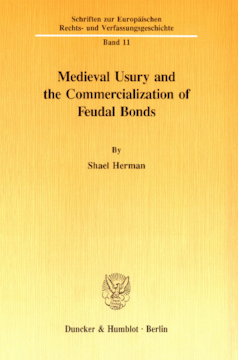Medieval Usury and the Commercialization of Feudal Bonds

BOOK
Cite BOOK
Style
Format
Medieval Usury and the Commercialization of Feudal Bonds
Schriften zur Europäischen Rechts- und Verfassungsgeschichte, Vol. 11
(1993)
Additional Information
Book Details
Pricing
Abstract
Die Reihe wurde 1990 in der Absicht gegründet, europäischen Gegenwartsfragen, insbesondere der damals noch jungen Frage der europäischen Rechtsangleichung, in historischen und historisch-vergleichenden Untersuchungen nachzugehen und der Diskussion um die rechts- und verfassungsgeschichtlichen Grundlagen Europas ein Forum zu bieten. Dieses Anliegen ist nach wie vor aktuell, gerade deswegen, weil inzwischen vielfältige Maßnahmen zur Rechtsangleichung in Europa eingeleitet wurden. Bisher sind etwa 60 Bände erschienen, teils Monographien, teils Themenbände, die aus Tagungen oder Seminaren hervorgegangen sind. Dogmengeschichtliche stehen neben historisch-vergleichenden Untersuchungen, wissenschaftsgeschichtliche neben kodifikationsgeschichtlichen Arbeiten. Privatrechts- und verfassungsgeschichtliche Titel bilden zwar den Schwerpunkt, doch bemüht sich die Reihe auch um andere Arbeiten zur Geschichte der europäischen Rechtskultur.
Table of Contents
| Section Title | Page | Action | Price |
|---|---|---|---|
| Geleitwort | 7 | ||
| Preface | 9 | ||
| Table of Contents | 11 | ||
| I. Introduction | 13 | ||
| II. The Church, Contrary to Its Roman Law Heritage, Condemns Lending at Interest | 19 | ||
| a) Roman Law as Damnosa Hereditas | 19 | ||
| b) The Church Rejects the Roman Practice of Lending at Interest | 19 | ||
| III. Theological Foundations of the Usury Ban and Its Evasions | 23 | ||
| IV. Commercialization of Feudal Bonds | 25 | ||
| a) Overview | 25 | ||
| b) Norman Financing Practices During the Tenth through Thirteenth Centuries | 26 | ||
| c) Landed Revenues as Natural Camouflage for Interest | 28 | ||
| d) Rents: A Natural Outgrowth of the Personal Bond of Lord and Vassal | 29 | ||
| e) Two Forms of Tenement Transfers: Subinfeudation and Substitution | 30 | ||
| aa) Substitution | 30 | ||
| bb) Subinfeudation | 30 | ||
| f) Commutation of Services: A Sign of Commercialization of Feudal Bonds | 32 | ||
| g) More Evidence of Commercialization of Feudal Bonds: Subinfeudation ut de vadio | 33 | ||
| h) The Nontenurial Rent: Both Euphemism and Convenient Disguise for Usury | 34 | ||
| i) Blurring Lease and Loan | 34 | ||
| j) Distraint: Compulsory Rendition of Rent Payments and Services | 36 | ||
| k) The “Thinglikeness” of Rents | 38 | ||
| V. French Experience with Gages, Subinfeudations, and Rents | 40 | ||
| a) Commercialization of Feudal Bonds in Medieval France | 40 | ||
| b) French Financing Practices | 42 | ||
| c) Waning Obstacles to Liquidating a Fee on Default | 43 | ||
| d) Jewish Lenders in France | 45 | ||
| VI. Recapitulation | 47 | ||
| VII. English Experience with Usurious Lending and Its Evasions | 48 | ||
| a) Jewish Lenders in England | 48 | ||
| b) Subinfeudations and the Locus of Creditor Leverage | 50 | ||
| c) Subinfeudations ut de feodo | 50 | ||
| d) Subinfeudations ut de feodo and ut de vadio Contrasted | 51 | ||
| e) Subinfeudations ut de vadio as Investment | 53 | ||
| f) Jewish Holdings by Subinfeudation | 53 | ||
| g) Christian Holdings by Subinfeudation | 54 | ||
| h) Royal Statutes Aimed at Investors in Encumbered Estates | 54 | ||
| i) Statutes of 1269 and 1271 Divest Jews of Encumbered Estates | 55 | ||
| j) Quia Emptores (1290) | 56 | ||
| k) Milsom’s Observations on Quia Emptores | 57 | ||
| l) Mortmain Statute [De Viris Religiosis] (1279) | 59 | ||
| m) Specific Instances of Subinfeudations ut de vadio | 63 | ||
| n) Westminster II: Elegit | 65 | ||
| VIII. Assize of the Jews (Assisam Judaismi) | 68 | ||
| IX. Conclusion | 76 | ||
| Appendix A: Charters of William de Valence made in Favour of Nicholas Fitzmartin Touching 50 Marks of Yearly Fee-Rent | 78 | ||
| Appendix B: Analysis of Charters | 82 | ||
| Endnotes | 86 | ||
| Bibliography | 123 | ||
| Index | 131 |
